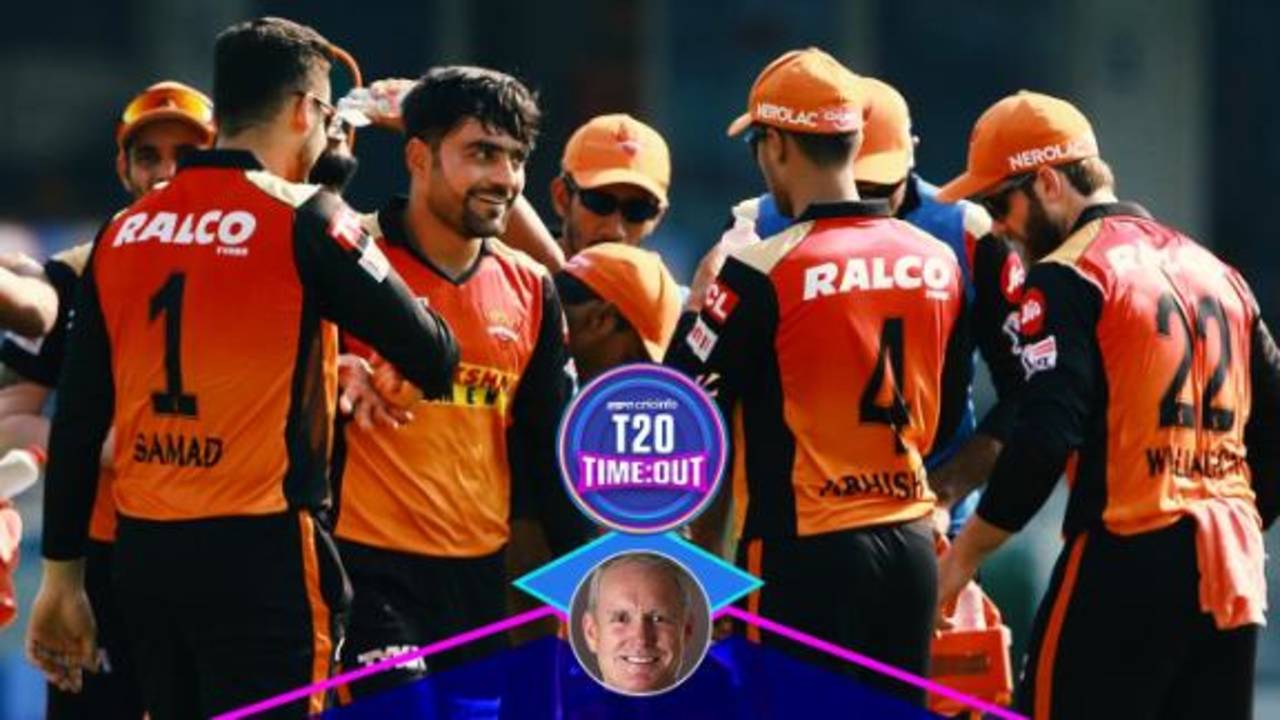Talking Points: Why did Kane Williamson bowl for Sunrisers Hyderabad?
Also, did Mumbai get their batting order right? And was there a case to use Rashid Khan more at the death?
Saurabh Somani
04-Oct-2020
ESPNcricinfo brings you all the talking points from the match between the Mumbai Indians and the Sunrisers Hyderabad in Sharjah on October 4.
Why did Kieron Pollard and Hardik Pandya defend the 16th over?
The Mumbai Indians were 147 for 4 in 15 overs, slightly below par given the small ground in Sharjah and Mumbai's batting strength. They had their two most fearsome death-overs hitters in Hardik Pandya and Kieron Pollard at the crease, but the 16th over yielded just one run off the bat and one wide, with the batsmen playing a succession of forward defensives.
The reason was simple: Rashid Khan. As it was the legspinner's final over of the innings, Pollard and Pandya calculated that they would be better off playing him out and maximising the 24 deliveries that would remain, rather than trying to hit big against him and risk losing their wickets. It's not just Khan's obvious quality as a bowler, Pollard and Pandya were playing the historical percentages too. They've both had trouble facing Khan in the IPL, scoring at an almost Test-match strike rate against him, with Pandya dismissed twice and Pollard out once.

Getty Images
Did Rashid Khan bowl at the right times?
With such a good record against Pollard and Pandya at the death, there was a case for Khan being used more as a death bowler by the Sunrisers. When he gave up just two runs in the 16th over, it showed that even in a six-friendly ground like Sharjah and against acknowledged power-hitters, Khan could dictate terms. The Sunrisers were also without an injured Bhuvneshwar Kumar, constraining their options at the death.
Khan bowled the 8th, 10th, 14th and 16th overs, but could have possibly bowled the 8th, 14th, 16th and 18th overs instead. Quinton de Kock and Ishan Kishan were well into their partnership but hadn't cut loose yet, so David Warner had the option to go to someone other than Khan for the 10th over. But, he had to weigh that option against the possibility of Mumbai taking the game out of the Sunrisers' reach if he held Khan back too much. After all, in Sharjah, the gap in the six-hitting abilities of other batsmen compared to Pollard and Pandya is reduced.
Did Mumbai get their batting order right?
The Sunrisers had already bowled 15 overs by the time Pollard walked in to bat. His and Pandya's batting positions have been interchangeable but both generally bat at five and six. Was there a case for them batting at four and five instead today? The high scores put up and chased down in Sharjah perhaps warranted greater use of the available firepower, so Mumbai could have considered pushing Kishan down from his regular No. 4 spot.
Rohit Sharma did say after the game that "the wicket looked good but it was slightly on the slower side so getting past 200 was a great effort". Perhaps the nature of the surface prompted Mumbai to stick with a more traditional batting order.
T20 batting lineups at this level are tough to put together. But I'm still not convinced about Pollard in this form only facing 13 balls at Sharjah.
— Ian bishop (@irbishi) October 4, 2020
Why did Kane Williamson bowl for Sunrisers?
Williamson's previous two bowling innings in T20 cricket were in February 2018 and January 2017, both for New Zealand. In the IPL, he had bowled one solitary over, back in 2016. That Warner still threw the ball to him was borne out of necessity and match-ups. Mumbai had two left-handers at the crease in de Kock and Kishan, and the Sunrisers didn't have an offspinner, having picked Williamson over Mohammad Nabi as the fourth overseas option.
Moreover, de Kock's record against offspin wasn't great: in IPL 2019 he faced 69 balls of offspin and could score only 65 runs, while being dismissed four times. The quality of bowlers de Kock had faced, though, was significant: 57 of the 65 balls he faced were from R Ashwin, Nabi, Harbhajan Singh and Sunil Narine.
Williamson bowled an economical first over but in the second, both de Kock and Kishan hit him for sixes.

Kane Williamson bowls•BCCI
Why did Mumbai bowl only one over of Rahul Chahar?
In their last match against the Kings XI Punjab, Rahul Chahar had been Mumbai's best bowler, with 2 for 26 in four overs. He was given the ball for the ninth over against the Sunrisers, and both Manish Pandey and Warner hit him for sixes over long-on in a 16-run over. Chahar's success against the Kings XI had come in Abu Dhabi; here in Sharjah, at a much smaller venue, he was punished for missing his lengths.
Moreover, Warner was at the crease and he would conceivably find it easier to hit the legspinner with the turn. After Chahar went for 16 runs in his opening over, Sharma immediately brought back James Pattinson from the other end to regain control.
Not letting the Sunrisers run away with the chase and always keeping them in check was a theme of Sharma's bowling choices. After Pattinson had bowled his over tightly, Krunal Pandya had a rare bad over that went for 15 runs. Immediately, Jasprit Bumrah was brought on. Sharma was perhaps gambling on the Sunrisers batsmen not being able to absorb the pressure of a mounting asking rate.
Saurabh Somani is an assistant editor at ESPNcricinfo
